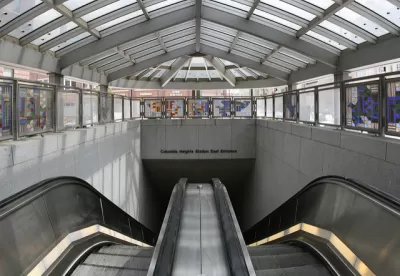The neighborhoods served by Washington D.C.'s Yellow Line have grown and it's time for the train to catch up.

Washington, DC's Mid-City neighborhoods are causing problems for the city's Metro train system. During rush hour, northbound Yellow Line trains need to pull backwards along track they have already covered to accommodate Green Line trains. According to Greater Greater Washington's Alex Cox, this problem was caused by "Massive redevelopment in Mid-City that began around the turn of the century, and has continued at a frantic pace to the present day. That has meant increased demand for service along the Green/Yellow Lines at all hours."
Unfortunately, when these trains were originally designed, they were not intended to run simultaneously at all hours of the day. They share some track and, as Cox points out, adding more track is not necessarily a simple solution because of the specific features along this stretch of track including turns and tunnels that would constrict new construction. It’s likely it would be costly to construct any additional pocket track to allow the trains to run simultaneously.

Planetizen Federal Action Tracker
A weekly monitor of how Trump’s orders and actions are impacting planners and planning in America.

Maui's Vacation Rental Debate Turns Ugly
Verbal attacks, misinformation campaigns and fistfights plague a high-stakes debate to convert thousands of vacation rentals into long-term housing.

Restaurant Patios Were a Pandemic Win — Why Were They so Hard to Keep?
Social distancing requirements and changes in travel patterns prompted cities to pilot new uses for street and sidewalk space. Then it got complicated.

In California Battle of Housing vs. Environment, Housing Just Won
A new state law significantly limits the power of CEQA, an environmental review law that served as a powerful tool for blocking new development.

Boulder Eliminates Parking Minimums Citywide
Officials estimate the cost of building a single underground parking space at up to $100,000.

Orange County, Florida Adopts Largest US “Sprawl Repair” Code
The ‘Orange Code’ seeks to rectify decades of sprawl-inducing, car-oriented development.
Urban Design for Planners 1: Software Tools
This six-course series explores essential urban design concepts using open source software and equips planners with the tools they need to participate fully in the urban design process.
Planning for Universal Design
Learn the tools for implementing Universal Design in planning regulations.
Heyer Gruel & Associates PA
JM Goldson LLC
Custer County Colorado
City of Camden Redevelopment Agency
City of Astoria
Transportation Research & Education Center (TREC) at Portland State University
Jefferson Parish Government
Camden Redevelopment Agency
City of Claremont





























